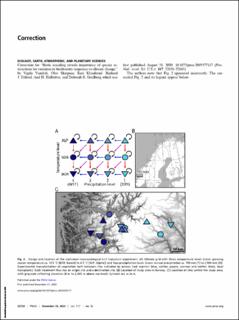| dc.contributor.author | Vandvik, Vigdis | |
| dc.contributor.author | Skarpaas, Olav | |
| dc.contributor.author | Klanderud, Kari | |
| dc.contributor.author | Telford, Richard J. | |
| dc.contributor.author | Halbritter, Aud Helen | |
| dc.contributor.author | Goldberg, Deborah E | |
| dc.date.accessioned | 2021-05-27T07:28:48Z | |
| dc.date.available | 2021-05-27T07:28:48Z | |
| dc.date.created | 2020-09-20T20:23:04Z | |
| dc.date.issued | 2020 | |
| dc.Published | Proceedings of the National Academy of Sciences of the United States of America. 2020, 117 (37), 22858-22865. | |
| dc.identifier.issn | 0027-8424 | |
| dc.identifier.uri | https://hdl.handle.net/11250/2756526 | |
| dc.description.abstract | Generality in understanding biodiversity responses to climate change has been hampered by substantial variation in the rates and even directions of response to a given change in climate. We propose that such context dependencies can be clarified by rescaling climate gradients in terms of the underlying biological processes, with biotic interactions as a particularly important process. We tested this rescaling approach in a replicated field experiment where entire montane grassland communities were transplanted in the direction of expected temperature and/or precipitation change. In line with earlier work, we found considerable variation across sites in community dynamics in response to climate change. However, these complex context dependencies could be substantially reduced or eliminated by rescaling climate drivers in terms of proxies of plant−plant interactions. Specifically, bryophytes limited colonization by new species into local communities, whereas the cover of those colonists, along with bryophytes, were the primary drivers of local extinctions. These specific interactions are relatively understudied, suggesting important directions for future work in similar systems. More generally, the success of our approach in explaining and simplifying landscape-level variation in climate change responses suggests that developing and testing proxies for relevant underlying processes could be a fruitful direction for building more general models of biodiversity response to climate change. | en_US |
| dc.language.iso | eng | en_US |
| dc.publisher | National Academy of Sciences | en_US |
| dc.rights | Attribution-NonCommercial-NoDerivatives 4.0 Internasjonal | * |
| dc.rights.uri | http://creativecommons.org/licenses/by-nc-nd/4.0/deed.no | * |
| dc.title | Biotic rescaling reveals importance of species interactions for variation in biodiversity responses to climate change | en_US |
| dc.type | Journal article | en_US |
| dc.type | Peer reviewed | en_US |
| dc.description.version | publishedVersion | en_US |
| dc.rights.holder | Copyright 2020 The Authors | en_US |
| cristin.ispublished | true | |
| cristin.fulltext | original | |
| cristin.qualitycode | 2 | |
| dc.identifier.doi | 10.1073/pnas.2003377117 | |
| dc.identifier.cristin | 1831445 | |
| dc.source.journal | Proceedings of the National Academy of Sciences of the United States of America | en_US |
| dc.source.40 | 117 | |
| dc.source.14 | 37 | |
| dc.source.pagenumber | 22858-22865 | en_US |
| dc.relation.project | Norges forskningsråd: 184912 | en_US |
| dc.identifier.citation | Proceedings of the National Academy of Sciences of the United States of America. 2020, 117 (37), 22858-22865 | en_US |
| dc.source.volume | 117 | en_US |
| dc.source.issue | 37 | en_US |

